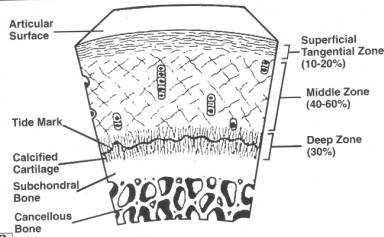Articular cartilage is divided into four basic layers. (Figure 12) The most superficial is called the tangential zone and makes up 10-20% of the cartilage thickness. The surface contains fine filamentous fibers that run tangential to the weight bearing surface and chondrocytes in this region are oriented parallel to the surface. This region of the cartilage is rich in collagen bundles and water but relatively deplete in proteoglycan. This makeup relates to the function of this region as the gliding surface and probably contributes less to shock absorption. The middle zone makes up 40-60% of the cartilage and consists of poorly organized collagen bundles with large diameters. The deep zone makes up 30% of the thickness and contains well-organized chondrocytes that form columns. This layer is rich in proteoglycans, but has very little water. Collagen fibrils are arranged perpendicularly to the weight-bearing surface. Just below this level the tidemark is encountered. This structure separates the deep zone from the calcified zone. Finally, the deep zone attaches the cartilage to the subchondral bone and contains small blue cells surrounded by a calcified cartilaginous matrix.
Figure 12


